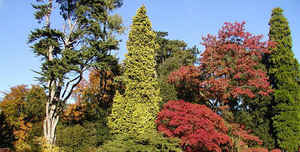
Washington, DC Tree
Scarlet Oak

(Fagaceae Quercus coccinea)
The scarlet oak (Quercus coccinea) is the official tree of the District of Columbia. The Scarlet oak, (Fagaceae Quercus coccinea,) also called black oak, red oak, or Spanish oak, is best known for its brilliant autumn color.
It has some of the most brilliant colors you will see this season. Its deep red autumn colors appear late in the fall season and give the tree its common name. The scarlet oak is native to the Eastern United States. Its habitat stretches along most of the Appalachian Mountains, but can also be found in Southern Indiana, Southeastern Missouri and Mississippi.
It is a large rapid-growing tree of the Eastern United States found on a variety of soils in mixed forests, especially light sandy and gravelly upland ridges and slopes. Best development is in the Ohio River Basin.
Washington, DC Tree: Scarlet Oak

In commerce, the lumber is mixed with that of other red oaks. Scarlet oak is a popular shade tree and has been widely planted in the United States and Europe. This oak tree has leaves which to the untrained eye may resemble the pin oaks, but it is very difficult to get these trees confused. For one thing, the scarlet oak has larger, round acorns, with deep cups that cover one third to one half of the nut. For another, the leaves of this oak often have red stems, and the points flare more than do the pin oaks. However, the best way to tell them apart in nature is to look at where they are growing.
The pin oak is found in floodplains and swamps. The Scarlet Oak will avoid these locations, and instead grow in dry, sandy, or rocky areas, such as the sandstone ridges of the Appalachians, the glacier scoured hills of southern New England, or the sands of the coastal plain.
Identification of the Scarlet Oak

Quercus coccinea, the scarlet oak, is an oak in the red oak section Quercus sect. Lobatae. The scarlet oak can be mistaken for the pin oak, the black oak, or occasionally the red oak. On scarlet oak the sinuses between lobes are "C"-shaped in comparison to pin oak (Q. palustris), which has "U"-shaped sinuses and the acorns are half covered by a deep cap.
Scarlet oak is mainly native to the eastern United States, from southern Maine west to eastern Oklahoma, and south to southern Alabama. It is also native in the extreme south of Ontario, Canada. It occurs on dry, sandy, usually acidic soils. It is often an important canopy species in an oak-heath forest.
- Common Names: Black oak, Red oak, Spanish oak, Spotted oak.
- Leaf: Alternate, simple, 3 to 7 inches long, oval in shape with very deep sinuses and bristle-tipped lobes. Leaves are waxy/shiny above. Leaves are generally hairless but may have tufts below in vein axils.
- Flower: Staminate flowers borne on catkins. Pistillate flowers borne on spikes. Appear with the leaves in April or May.
- Fruit: Acorns are 1/2 to 1 inch long, with a scaled cap covering 1/2 of the nut. Cap scales look varnished. The tip of the acorn may have concentric rings. Maturing in two years, ripening in the fall.
- Twig: Slender, red-brown in color with multiple terminal buds. Buds are pointed, slightly angled, and covered with a light colored pubescence on the top half.
- Bark: On young trees, gray-brown, with smooth streaks. Later developing irregular ridges and furrows. Much later turning darker and scaly (resembling black oak).
- Form: A medium-sized tree with generally poor form, irregular crown, and many dead branches. A butt-swell is often noticeable, and often is useful in identification.

Taxonomic Hierarchy: Scarlet Oak
Kingdom: Plantae - Plants
Subkingdom: Tracheobionta - Vascular plants
Superdivision: Spermatophyta - Seed plants
Division: Magnoliophyta - Flowering plants
Class: Magnoliopsida - Dicotyledons
Subclass: Hamamelididae
Order: Fagales
Family: Fagaceae - Beech family
Genus: Quercus L. - oak
Species: Quercus coccinea Muenchh. - scarlet oak







